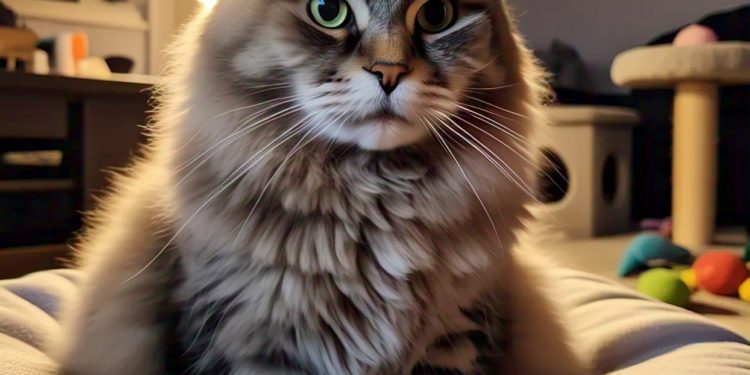When a female cat (queen) goes into heat, she can exhibit restlessness, excessive vocalization, and increased affection or agitation. This phase, known as estrus, can be distressing for both the cat and the owner. Understanding how to comfort and manage a cat in heat is essential to keep her calm and reduce stress.
In this guide, we’ll cover:
✅ How to recognize signs of heat.
✅ Ways to comfort and soothe a cat in heat.
✅ Tips to manage unwanted behaviors.
✅ Long-term solutions, including spaying.
1. Understanding a Cat in Heat: Signs and Duration
Before you can comfort a cat in heat, it’s important to recognize the signs and duration of the cycle.
🔹 What Does It Mean When a Cat Is in Heat?
A cat in heat is going through a reproductive cycle where she is fertile and looking for a mate. Unlike dogs, cats are induced ovulators, meaning they only release eggs if they mate.
🔹 When Do Cats First Go Into Heat?
- Cats typically reach sexual maturity between 4-6 months old.
- Some breeds, like Siamese, may go into heat as early as 4 months.
🔹 How Often Do Cats Go Into Heat?
- Cats are seasonally polyestrous, meaning they can go into heat multiple times a year (especially in warmer months).
- If they don’t mate, they will go back into heat every 2-3 weeks.
🔹 How Long Does a Cat Stay in Heat?
- The heat phase lasts 4-10 days, but if the cat doesn’t mate, she may enter another cycle soon after.
2. Signs of a Cat in Heat
🐾 Physical Signs:
✅ Excessive grooming of the genital area.
✅ Rolling on the floor frequently.
✅ Raising hindquarters and treading with back legs when touched.
✅ Swollen vulva (though less noticeable than in dogs).
🐾 Behavioral Signs:
✅ Loud yowling (calling for a mate).
✅ Increased affection (rubbing against furniture, people, or objects).
✅ Restlessness and hyperactivity.
✅ Frequent urination or spraying to mark territory.
✅ Escape attempts—trying to get outside to find a mate.
🚨 Important: If your cat has excessive bleeding, extreme lethargy, or shows signs of pain, contact a vet immediately, as these are not typical heat symptoms.
3. How to Comfort a Cat in Heat
Helping a cat through her heat cycle involves soothing her discomfort and preventing unwanted mating behaviors.
🔒 Keep Her Indoors & Secure
- Do not let her outside—male cats can detect a female in heat from miles away.
- Close windows, doors, and pet flaps to prevent escape.
- Keep her away from intact male cats in the house.
🧘 Provide Comfort & Calm Environment
- Give her a warm blanket or heating pad to snuggle with.
- Create a quiet, dark space where she can retreat if overstimulated.
- Use white noise or calming music to drown out mating calls from male cats outside.
🌿 Use Pheromone Diffusers or Natural Remedies
- Feliway diffusers mimic feline pheromones, helping to calm anxiety.
- Catnip may have a calming effect on some cats, while it excites others—observe her reaction.
- Try chamomile or valerian root (consult your vet first).
🧩 Distract with Play & Exercise
- Interactive play sessions with wand toys can redirect her energy.
- Provide puzzle feeders or treat-dispensing toys to engage her mind.
- Play sessions can help reduce hyperactivity and yowling.
🚿 Keep Her Clean
- Cats in heat may overgroom, so gently wipe her fur with a damp cloth if needed.
- Keep the litter box extra clean, as she may urinate more frequently.
4. Managing Unwanted Heat Behaviors
🔇 How to Reduce Excessive Yowling
✅ Avoid punishing or scolding—this will only cause stress.
✅ Speak to her in a soft, reassuring voice.
✅ Try gentle petting on the head or back (but avoid lower back if it triggers mating behaviors).
🚫 Prevent Escape Attempts
✅ Block potential escape routes (windows, doors, balcony gaps).
✅ Consider double-checking screens and barriers for security.
✅ Provide vertical spaces (cat trees or shelves) to satisfy climbing urges indoors.
🛏 Manage Marking & Spraying
✅ Use enzymatic cleaners to remove urine odors.
✅ Try a covered litter box to encourage proper urination.
✅ If she sprays, redirect her behavior with play or treats.
5. Long-Term Solution: Spaying
Spaying (ovariohysterectomy) is the best way to prevent heat cycles and unwanted pregnancy.
🔹 Benefits of Spaying:
✔ Eliminates heat cycles and behavioral stress.
✔ Prevents uterine infections (pyometra).
✔ Reduces risk of mammary cancer (especially if done before first heat).
✔ Helps prevent territorial spraying and marking.
🔹 When Should You Spay a Cat?
- Vets recommend spaying at 4-6 months, before the first heat cycle.
- Older cats can still be spayed safely.
🔹 Alternatives to Spaying:
If you don’t want to spay, you must manage every heat cycle with extreme care, keeping her indoors and isolated from males.
6. Common Myths About Cats in Heat
❌ Myth 1: A Cat Must Have One Litter Before Spaying
✅ False! Spaying before the first heat reduces cancer risks.
❌ Myth 2: A Cat in Heat Is in Pain
✅ False! Heat is uncomfortable but not painful.
❌ Myth 3: Cats Only Go Into Heat Once a Year
✅ False! Cats can go into heat every few weeks if they don’t mate.
❌ Myth 4: Indoor Cats Don’t Go Into Heat
✅ False! Indoor cats can have heat cycles year-round due to artificial lighting.
Final Thoughts: Helping Your Cat Through Heat
Understanding how to comfort a cat in heat is key to maintaining her well-being and reducing stress.
✅ Recognize signs of heat and understand the cycle.
✅ Keep her indoors and secure to prevent escape.
✅ Provide a calm environment, warmth, and distractions.
✅ Consider spaying for a long-term solution.
By following these steps, you can ensure a happier and more comfortable experience for both you and your feline companion!

























